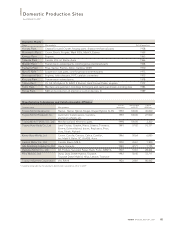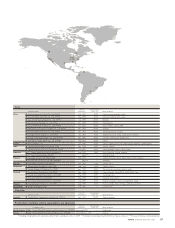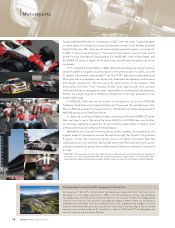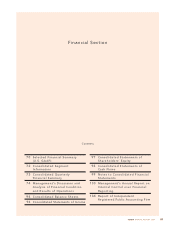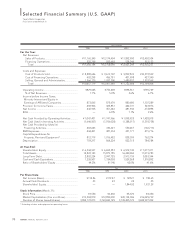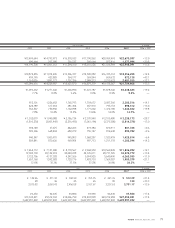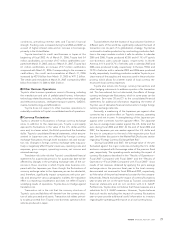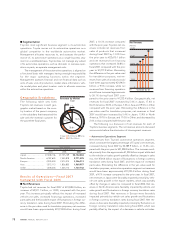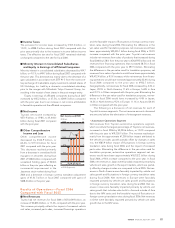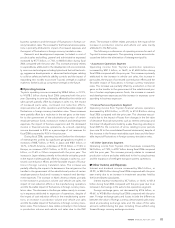Toyota 2007 Annual Report Download - page 77
Download and view the complete annual report
Please find page 77 of the 2007 Toyota annual report below. You can navigate through the pages in the report by either clicking on the pages listed below, or by using the keyword search tool below to find specific information within the annual report.
ANNUAL REPORT 2007 75
Changes in laws, regulations, policies and other governmen-
tal actions can also materially impact the profitability of Toyota’s
automotive operations. These laws, regulations and policies include
those attributed to environmental matters and vehicle safety, fuel
economy and emissions that can add significantly to the cost of
vehicles. The European Union has enforced a directive that requires
manufacturers to be financially responsible for taking back end-
of-life vehicles and to take measures to ensure that adequate
used vehicle disposal facilities are established and those hazardous
materials and recyclable parts are removed from vehicles prior to
scrapping. Please see “–Legislation Regarding End-of-Life
Vehicles” and “Information on the Company–Business Overview–
Governmental Regulation, Environmental and Safety Standards”
and note 23 to the consolidated financial statements for a more
detailed discussion of these laws, regulations and policies.
Many governments also regulate local content, impose tariffs
and other trade barriers, and enact price or exchange controls
that can limit an automaker’s operations and can make the repa-
triation of profits unpredictable. Changes in these laws, regula-
tions, policies and other governmental actions may affect the
production, licensing, distribution or sale of Toyota’s products,
cost of products or applicable tax rates. Toyota is currently one of
the defendants in purported national class actions alleging viola-
tions of the U.S. Sherman Antitrust Act. Toyota believes that its
actions have been lawful. In the interest of quickly resolving these
legal actions, however, Toyota entered into a settlement agree-
ment with the plaintiffs at the end of February 2006. The settle-
ment agreement is pending the approval of the federal district
court, and immediately upon approval the plaintiffs will, in accor-
dance with the terms of the settlement agreement, withdraw all
pending actions against Toyota in the federal district court as
well as all state courts and all related actions will be closed. For a
more detailed description of these proceedings, see note 23 to
the consolidated financial statements.
The worldwide automotive industry is in a period of
globalization, which may continue for the foreseeable future, and
in general the competitive environment in which Toyota operates
is likely to intensify. Toyota believes it has the resources, strate-
gies and technologies in place to compete effectively in the
industry as an independent company for the foreseeable future.
In October 2004, Araco Corporation (“Araco”) spun off its
automotive manufacturing business that was merged into Toyota
Auto Body Co., Ltd. while the remaining operations of Araco
were merged with Takanichi Co., Ltd. (“Takanichi”) and Toyoda
Boshoku Corporation to become Toyota Boshoku Corporation
(“Toyota Boshoku”). As a result, Toyota’s ownership interests in
Toyota Boshoku increased to 49.63% and Toyota Boshoku has
been accounted for using the equity method since the latter half
of fiscal 2005. Prior to the merger, Araco and Takanichi were con-
solidated subsidiaries of Toyota and included their financial
results in Toyota’s consolidated financial statements. Toyota
Boshoku is primarily engaged in the development, manufactur-
ing and sales of automotive interior and filter parts.
■Financial Services Operations
The worldwide automobile financial
services industry is highly competi-
tive. The market for automobile
financing has grown as more con-
sumers are financing their pur-
chases, primarily in North America
and Europe. As competition increas-
es, margins on financing transac-
tions may decrease and market
share may also decline as cus-
tomers obtain financing for Toyota
vehicles from alternative sources.
Toyota’s financial services oper-
ations mainly include loans and
leasing programs for customers and
dealers. Toyota believes that its
ability to provide financing to its
customers is an important value
added service. Therefore, Toyota intends to continue to expand
its network of finance subsidiaries in order to offer financial ser-
vices in more countries.
Toyota’s competitors for retail financing and retail leasing
include commercial banks, credit unions, and other finance com-
panies. Meanwhile, commercial banks and other captive automo-
bile finance companies also provide competition for Toyota’s
wholesale financing activities.
Toyota’s financial assets increased during fiscal 2007 resulting
primarily from the continued expansion of its financial services
operations in North America.
16,000
8,000
4,000
12,000
0
Total Assets by Financial
Services Operations
(¥ Billion)
FY ’04’03 ’05 ’06 ’07


